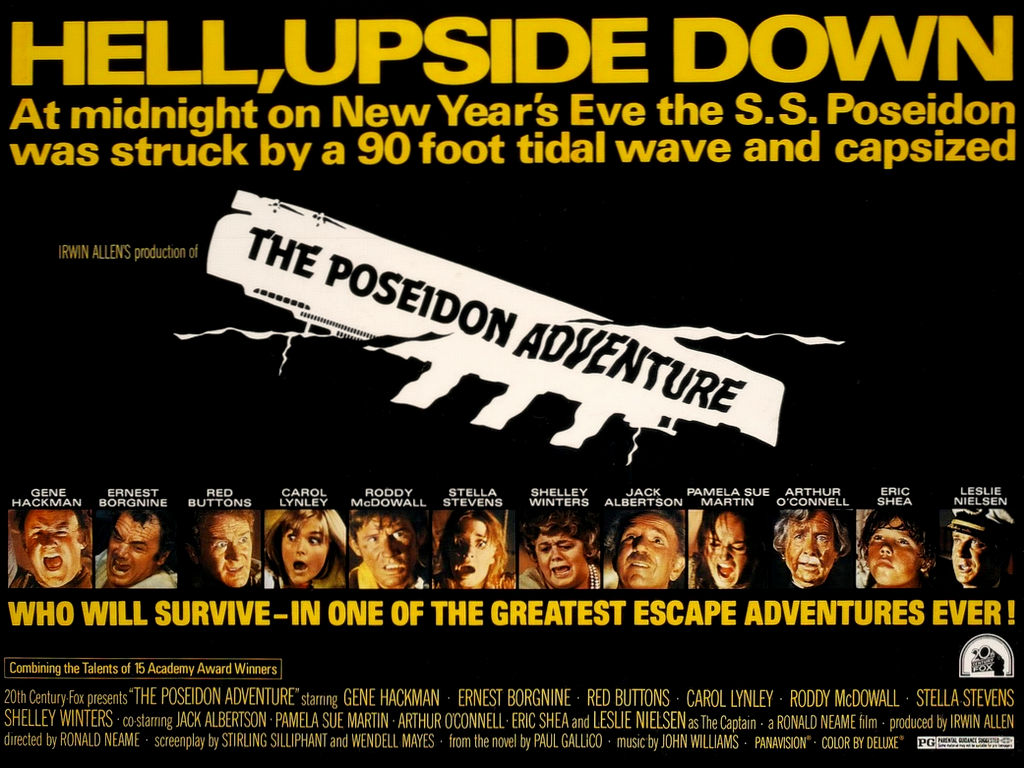Favorite screenplays: The Poseidon Adventure part 1
The Poseidon Adventure was the first new, “grown up” movie I ever saw. I think the last movie I had seen previous to it was The Aristocats. People generally feel The Poseidon Adventure to be ham-fisted, stale and clunky, but in the winter of 1973 it was pretty mind-blowing, especially to an 11-year-old boy, and it changed the way I felt about movies forever. I would never be happy with Herbie Rides Again or The Apple Dumpling Gang after I had seen mass death and gripping adventure in the passageways of a capsized ocean liner.
The early 1970s was a good time to be a young teenaged boy going to the movies. The Poseidon Adventure was rated PG, despite having a lot of swearing, gruesome deaths and children in peril. Papillon, also PG, featured beheadings, stabbings, anal sex, lepers and an island of topless natives. The Seven Ups, again PG, had drug use, corrupt cops, a landmark chase and even a strip club scene.
My father had read the novel of The Poseidon Adventure and greatly wanted to see the movie, and, for some reason, he had charge of the children on New Year’s Even 1972. He packed us into the Buick and took us off to a neighboring town (our town was too small to have a first-run theater) to catch the movie at the 10:00 show, but it was sold out. Instead, we went to the midnight show, which made the whole thing more exciting to me. I was seeing a grown-up movie, set in an ocean liner at midnight on New Year’s Eve, at midnight on New Year’s Eve.
Afterward, my father took us out for dessert at a 24-hour diner. He let us know that the movie had displeased him. He found it base, crass and sluggish. Me, I was still stunned. I had just spent two hours in a capsized ocean liner, I could barely believe what I’d seen. My father asked me what I liked about the movie. I said “I liked the fat lady,” and my father drew his head haught, sniffed and said “That fat lady was Shelley Winters.”
Many years later in the day of DVD, I bought The Poseidon Adventure to relive my childhood thrills and to see how it held up. I found that, yes, the script is ham-fisted, crass and obvious, but I also found that it was earnest, thrilling and compelling. More than that, I found it contained a metaphor, something that was new to me at the time.
The ship is upside-down. Is that mere contrivance, or does it mean something? It’s true, there is no “movie” if the ship is not upside-down, but why upside-down, why not “sinking” or “on fire?” I found that if I extended the conceit two little words further, that the ship is a ship “of state,” the movie became a startling parable of American life.
Keep in mind this is Christmas 1972. In spite of the Watergate break-in and the unending misery of the war in Viet Nam, Richard Nixon had just been elected — in a massive landslide — to his second term of office. The ship of state, many felt, was, indeed, upside-down.
But let’s move past America for a moment. In 1972 the world felt upside-down. The wounds of the 1960s were still raw, the era of the oil sheiks was blossoming, the sexual revolution was changing the way everyone thought about everything. What was certain? What was stable? How could one deal with the enormous changes working their might on people?
And then, in Hollywood, the movie business felt upside-down. Three years after Easy Rider, 1972 was a high-water mark of “nobody knows what the hell is going on any more.” Old-style Hollywood glamour was out, gritty naturalism was in. John Wayne was no longer a movie star, Dustin Hoffman was. The posters read “WHO WILL SURVIVE,” Hollywood could have been addressing itself.
Watching the movie again the other day with my son, 10, brought other aspects of the production to light. The 1970s gritty naturalism I mentioned before is almost entirely absent from The Poseidon Adventure — from the production design to the direction to the casting, it’s Old Hollywood Glamour all the way. With the curious exception of one actor. Gene Hackman, playing the lead, playing the rebellious priest, had just won an Oscar for The French Connection, and was the personification of the New Hollywood leading man — unhandsome, un-ingratiating, and possessed of real talent. An anti-star. In putting Gene Hackman in charge of the boat’s crew of Hollywood Dependables, the movie wears its heart on its sleeve — it’s a movie about New Hollywood leading Old Hollywood to the sunlight.

I wonder what the last movie was that was seriously marketed by having a row of tiny mugshots of the actors on the poster?
Dare I say, another disaster movie? http://www.slantmagazine.com/images/house/film/posterlabnewyearseve.jpg
Good point. Though that adds the extra layer of oddness by the names up top not lining up with the photos, making me first think, “Wow, that mustache on Jessica Biel is not a good look for her!”
I wonder what the last movie poster was to align the actors’ names with their faces?
It seems to me that it was fairly common in the 1970s for some reason, and not just for disaster movies. For instance, this poster for the 1975 Charles Bronson vehicle Breakout:
file:///Users/toddalcott/Desktop/tumblr_l83lpp3rZa1qavxpso1_500.jpeg